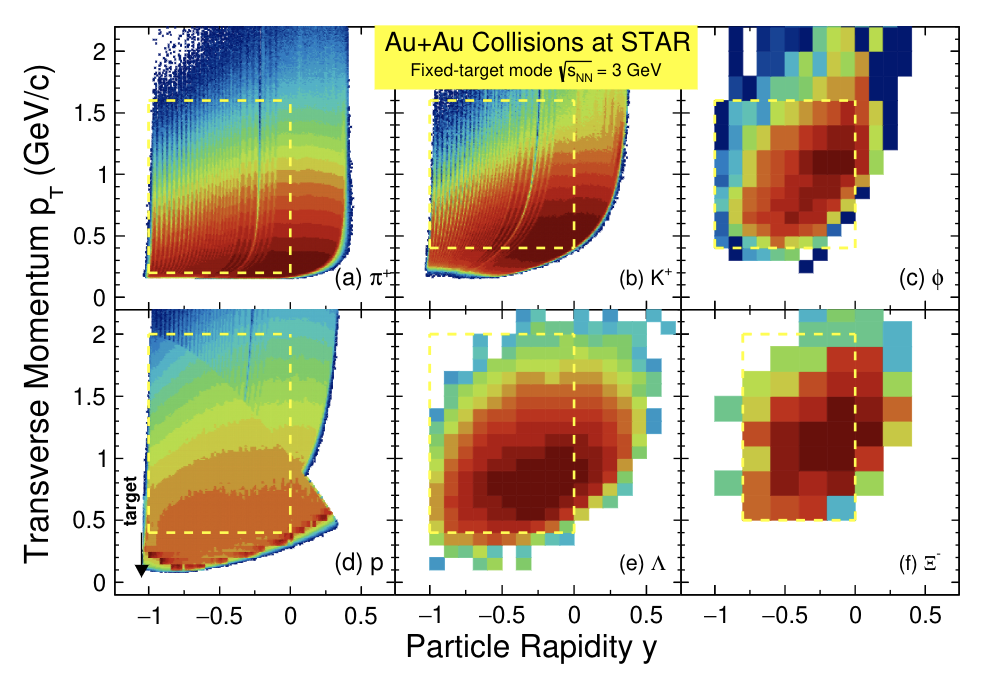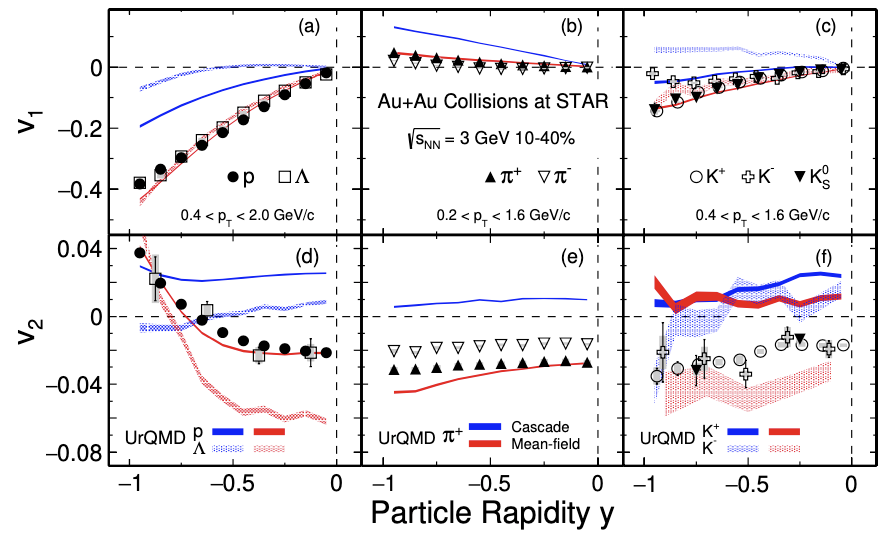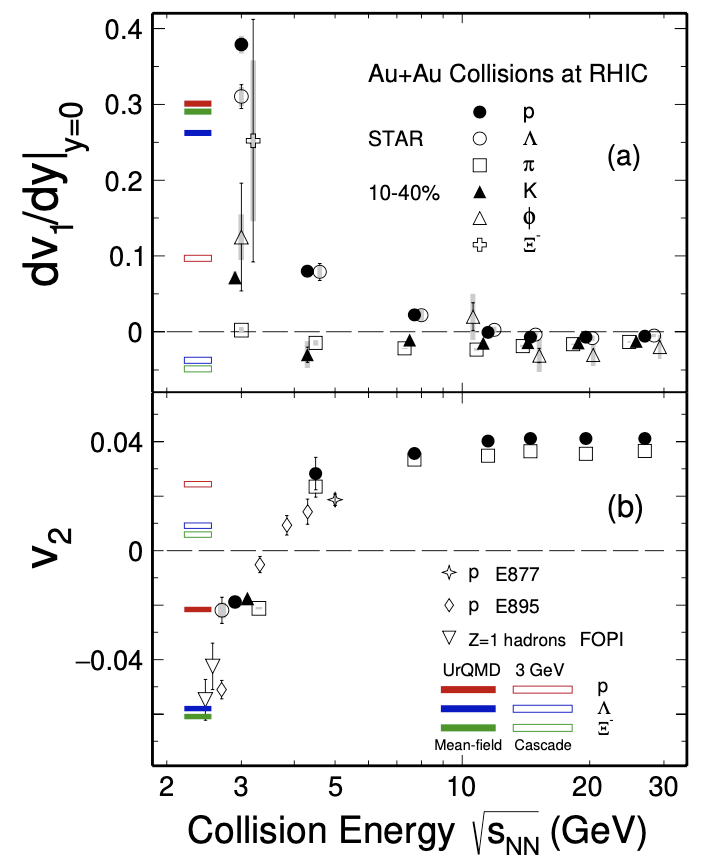3gevflow
Title: Disappearance of partonic collectivity in $\sqrt{s_{NN}}$ = 3 GeV Au+Au collisions at RHIC
PAs: Xin Dong, Shaowei Lan, Yue-Hang Leung, Sooraj Radhakrishnan, Shusu Shi, Yang Wu, Yaping Wang, Guannan Xie, Nu Xu, Yingjie Zhou
Target Journal: Phys. Rev. Lett.
Paper draft: https://drupal.star.bnl.gov/STAR/blog/slan/3-gev-paper-draft
Analysis note: https://drupal.star.bnl.gov/STAR/blog/slan/3-gev-analysis-note
GPC comments: https://drupal.star.bnl.gov/STAR/blog/slan/gpc-comment-0764
Abstract:
We report the measurements of directed and elliptic flows ($v_1$ and $v_2$) for identified hadrons ($\pi^{\pm}$, $K^{\pm}$, $K_{s}^0$, $p$, $\phi$ and $\Lambda$) from Au+Au collisions at a center-of-mass-energy \snn = 3\,GeV and $v_{2}$ of ($\pi^{\pm}$, $K^{\pm}$, $p$ and $\bar{p}$) at 27\,GeV and 54.4\,GeV with the STAR experiment. It is found that at the two higher collision energies, in the mid-central collisions, the number-of-constituent-quark (NCQ) scaling holds and is consistent with previous measurements at similar collision energies. On the other hand, in \snn = 3\,GeV collisions, the mid-rapidity $v_{2}$ is negative for all hadrons and the NCQ scaling, observed in high collision energy, is absent. In addition, the mid-rapidity slopes d$v_{1}$/dy$|_{y=0}$ for almost all observed hadrons are found to be positive implies dominant repulsive baryonic interactions. The features of negative $v_2$ at midrapidity and positive $v_1$ slope at 3 GeV can be reproduced with a baryonic mean-field in transport model calculations. These results imply a medium, different from the partonic equation-of-state at higher energy collisions, has been produced in the 3 GeV Au+Au collisions at RHIC.
Figures:
Fig.1

FIG. 1: The transverse momentum ($p_{T}$) versus the identified particle rapidity (y) for $\pi^{+}$, $K^{+}$, $\phi$, $p$, $\Lambda$ and $\Xi^{-}$ measured by STAR detector TPC and TOF in Au+Au collisions at \snn = 3 GeV, with the fixed-target mode of beam energy 3.85 GeV per nucleon. The target is located at y = -1.045.
Fig. 2

FIG. 2: Rapidity(y) dependence of $v_{1}$ (top panels) and $v_{2}$ (bottom panels) of proton and $\Lambda$ baryons (left panels), pions (middle panels) and kaons (right panels) in 10-40\% centrality for the \snn = 3 GeV Au+Au collisions. Statistical and systematic uncertainties are shown as bars and gray bands, respectively. The UrQMD results are shown as bands: red and blue band stand for mean-field and cascade mode, respectively. The parameter of the impressibility $\kappa$ = 380 MeV is used in the mean-field option.
Fig. 3

FIG . 3: Scaled $v_2$ by number of constituent quarks, $v_2/n_{q}$, as a function of scaled transverse kinetic energy ($(m_{T}-m_{0})/n_{q}$) for pion, kaon and proton from Au+Au collisions in 10-40\% centrality at \snn = 3 GeV, 27 GeV, and 54.4 GeV for positive charged particles (panel a) and negative charged particles (panel b). Colored dash lines represent the fit to data in 200 GeV - 7.7 GeV collisions from STAR experiment at RHIC. Statistical and systematic uncertainties are shown as bars and gray bands, respectively.
Fig.4

FIG. 4: Collision energy dependence of (panel a) directed flow slope $dv_{1}/dy|_{y=0}$ for $p$, $\Lambda$, $\pi$(combined from $\pi^{\pm}$), $K$(combined from $K^{\pm}$ and $K^{0}_{S}$), $\phi$ and $\Xi^{-}$ and (panel b) elliptic flow $v_2$ for $p$, $\pi$(combined from $\pi^{\pm}$) in heavy-ion collisions. All collision centrality from RHIC is 10-40\% except 4.5 GeV where 10-30\% for $dv_{1}/dy|_{y=0}$ and 0-30\% for $v_{2}$. Statistical and systematic uncertainties are shown as bars and gray bands, respectively. The UrQMD results are shown as colored bands: solid- and shaded-bands stand for mean-field and cascade mode, respectively. With the mean-field option with $\kappa=380$ MeV, the model predicted positive values of $dv_{1}/dy|_{y=0}$ and negative values of $v_2$ for all baryons. For clarity the x-axis value of the data points have been shifted.
Conclusions:
Support Documents:
QM19_poster (27 and 54.4 GeV): https://drupal.star.bnl.gov/STAR/system/files/QM19_poster_shaowei_v6.pdf
DNP 2020_presentation (3 GeV): https://drupal.star.bnl.gov/STAR/system/files/DNP2020_Shaowei.pdf
CPOD 2021: https://indico.cern.ch/event/985460/contributions/4264583/attachments/2207921/3736131/CPOD21_Shaowei.pdf
Presentations:
27 and 54.4 GeV:
https://drupal.star.bnl.gov/STAR/system/files/PID_flow_0716.pdf
https://drupal.star.bnl.gov/STAR/system/files/PIDflow_1213.pdf
https://drupal.star.bnl.gov/STAR/system/files/bulkcor_0522.pdf
3 GeV:
https://www.star.bnl.gov/protected/heavy/xgn1992/run18/20200610_BulkCor_GXie.pdf
https://drupal.star.bnl.gov/STAR/system/files/shaowei_0603.pdf
https://drupal.star.bnl.gov/STAR/system/files/shaowei_0715.pdf
https://drupal.star.bnl.gov/STAR/system/files/0930_shaowei.pdf
https://drupal.star.bnl.gov/STAR/system/files/1007_shaowei.pdf
https://drupal.star.bnl.gov/STAR/system/files/YueHangLeung-bulkcorr20200722.pdf
https://drupal.star.bnl.gov/STAR/system/files/210224_3GeV_Xiv1.pdf
https://drupal.star.bnl.gov/STAR/system/files/210407_3GeV_Xiv1_pwg.pdf
PWGC preview:
https://drupal.star.bnl.gov/STAR/system/files/Shaowei_PWGC_11132020.pdf
Questions and comments:
https://lists.bnl.gov/pipermail/star-fcv-l/Week-of-Mon-20201109/000293.html
Answer:
https://drupal.star.bnl.gov/STAR/system/files/shaowei_20210127.pdf
psn0764: psn0764
- slan's blog
- Login or register to post comments
